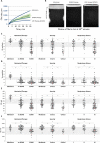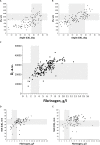Integral assays of hemostasis in hospitalized patients with COVID-19 on admission and during heparin thromboprophylaxis
- PMID: 37267317
- PMCID: PMC10237390
- DOI: 10.1371/journal.pone.0282939
Integral assays of hemostasis in hospitalized patients with COVID-19 on admission and during heparin thromboprophylaxis
Abstract
Background: Blood coagulation abnormalities play a major role in COVID-19 pathophysiology. However, the specific details of hypercoagulation and anticoagulation treatment require investigation. The aim of this study was to investigate the status of the coagulation system by means of integral and local clotting assays in COVID-19 patients on admission to the hospital and in hospitalized COVID-19 patients receiving heparin thromboprophylaxis.
Methods: Thrombodynamics (TD), thromboelastography (TEG), and standard clotting assays were performed in 153 COVID-19 patients observed in a hospital setting. All patients receiving treatment, except extracorporeal membrane oxygenation (ECMO) patients (n = 108), were administered therapeutic doses of low molecular weight heparin (LMWH) depending on body weight. The ECMO patients (n = 15) were administered unfractionated heparin (UFH).
Results: On admission, the patients (n = 30) had extreme hypercoagulation by all integral assays: TD showed hypercoagulation in ~75% of patients, while TEG showed hypercoagulation in ~50% of patients. The patients receiving treatment showed a significant heparin response based on TD; 77% of measurements were in the hypocoagulation range, 15% were normal, and 8% remained in hypercoagulation. TEG showed less of a response to heparin: 24% of measurements were in the hypocoagulation range, 59% were normal and 17% remained in hypercoagulation. While hypocoagulation is likely due to heparin treatment, remaining in significant hypercoagulation may indicate insufficient anticoagulation for some patients, which is in agreement with our clinical findings. There were 3 study patients with registered thrombosis episodes, and all were outside the target range for TD parameters typical for effective thromboprophylaxis (1 patient was in weak hypocoagulation, atypical for the LMWH dose used, and 2 patients remained in the hypercoagulation range despite therapeutic LMWH doses).
Conclusion: Patients with COVID-19 have severe hypercoagulation, which persists in some patients receiving anticoagulation treatment, while significant hypocoagulation is observed in others. The data suggest critical issues of hemostasis balance in these patients and indicate the potential importance of integral assays in its control.
Copyright: © 2023 Bulanov et al. This is an open access article distributed under the terms of the Creative Commons Attribution License, which permits unrestricted use, distribution, and reproduction in any medium, provided the original author and source are credited.
Conflict of interest statement
The authors have declared that no competing interests exist.
Figures




References
Publication types
MeSH terms
Substances
LinkOut - more resources
Full Text Sources
Medical

